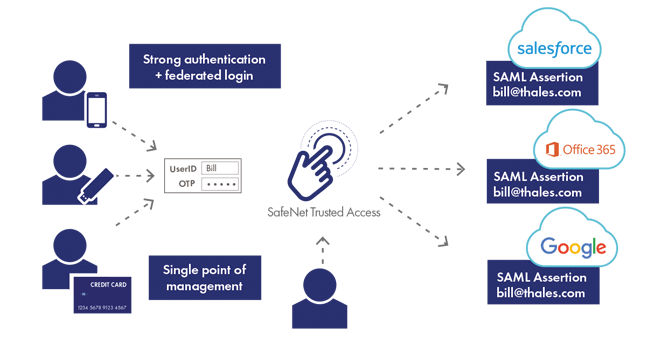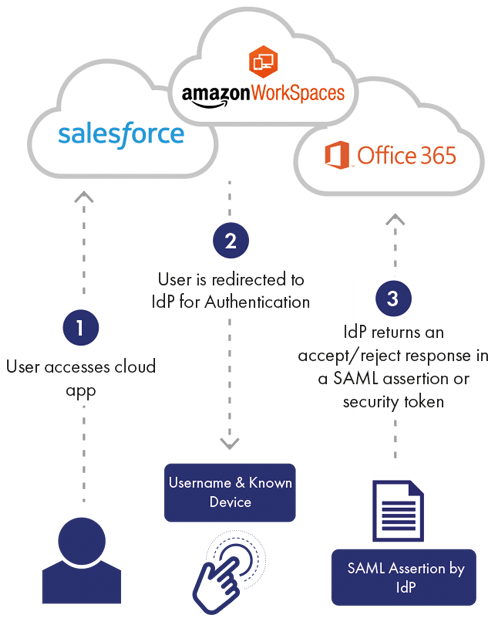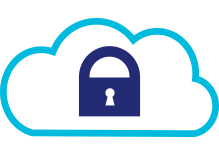
SAML Authentication
SAML Authentication is a method of identity verification that leverages an identity provider to authenticate users centrally to a broad range of unaffiliated websites.
- Product Summary
- Product Details
-
SAML Authentication is a method of identity verification that leverages an identity provider to authenticate users centrally to a broad range of unaffiliated websites.
-
What is SAML Authentication?
SAML Authentication is a method of identity verification that leverages an identity provider to authenticate users centrally to a broad range of unaffiliated websites. By relaying the authentication process to a single trusted identity provider, organizations realize numerous security, administration and cost savings benefits, and above all, relieve users of the need to maintain dozens of different usernames and passwords.
Created by the OASIS non-profit consortium, SAML, or the security assertion markup language, is an open-source XML standard, or protocol, for exchanging authentication and authorization information between an identity provider, such as SafeNet Trusted Access, and a relying party or service provider, meaning a cloud or web app, such as such as Office 365, Salesforce, AWS, Zendesk, DropBox etc.
Token-based authentication, security token services, federated authentication and identity federation are all terms that describe the capabilities that a SAML identity provider offers.
How does SAML Authentication Work?
1. With SAML authentication, each time a user accesses an app, the authentication process is relayed to the SAML identity provider.
2. The user enters their credentials (e.g. password, OTP, contextual attributes), which are then verified by the identity provider.
3. The identity provider returns an access or reject response in the form of a SAML assertion. If authentication is successful, the user is granted access to the resource, and if not, access is denied.
What is the User Experience with SAML Authentication?
1. A user accesses an app, and is redirected to the identity provider for authentication.
2. They enter their credentials into the login portal.
3. Upon successful authentication, they are logged in to the resource.Benefits of SAML Authentication in the Enterprise
Why SafeNet Trusted Access for SAML Authentication?
 Each cloud and web application works with a different set of SAML attributes, which may include one or more of various fields such as User ID, email address, group membership, postal address, alias and others. Therefore, in order to successfully integrate a central SAML identity provider with a cloud or web app, the identity provider must be able to provide these details in the SAML assertion.
Each cloud and web application works with a different set of SAML attributes, which may include one or more of various fields such as User ID, email address, group membership, postal address, alias and others. Therefore, in order to successfully integrate a central SAML identity provider with a cloud or web app, the identity provider must be able to provide these details in the SAML assertion.SafeNet Trusted Access makes it a breeze to apply single sign on using SAML authentication, as it offers a catalogue of pre-integrated applications. Just add the cloud or web app that you already use today, and start applying Smart Single Sign-On with business-driven access policies.
More than: https://cpl.thalesgroup.com/access-management/saml-authentication
Product Summary
SAML Authentication is a method of identity verification that leverages an identity provider to authenticate users centrally to a broad range of unaffiliated websites.
Product Details
What is SAML Authentication?
SAML Authentication is a method of identity verification that leverages an identity provider to authenticate users centrally to a broad range of unaffiliated websites. By relaying the authentication process to a single trusted identity provider, organizations realize numerous security, administration and cost savings benefits, and above all, relieve users of the need to maintain dozens of different usernames and passwords.
Created by the OASIS non-profit consortium, SAML, or the security assertion markup language, is an open-source XML standard, or protocol, for exchanging authentication and authorization information between an identity provider, such as SafeNet Trusted Access, and a relying party or service provider, meaning a cloud or web app, such as such as Office 365, Salesforce, AWS, Zendesk, DropBox etc.
Token-based authentication, security token services, federated authentication and identity federation are all terms that describe the capabilities that a SAML identity provider offers.
How does SAML Authentication Work?
1. With SAML authentication, each time a user accesses an app, the authentication process is relayed to the SAML identity provider.
2. The user enters their credentials (e.g. password, OTP, contextual attributes), which are then verified by the identity provider.
3. The identity provider returns an access or reject response in the form of a SAML assertion. If authentication is successful, the user is granted access to the resource, and if not, access is denied.

What is the User Experience with SAML Authentication?
1. A user accesses an app, and is redirected to the identity provider for authentication.
2. They enter their credentials into the login portal.
3. Upon successful authentication, they are logged in to the resource.
Benefits of SAML Authentication in the Enterprise
Why SafeNet Trusted Access for SAML Authentication?
 Each cloud and web application works with a different set of SAML attributes, which may include one or more of various fields such as User ID, email address, group membership, postal address, alias and others. Therefore, in order to successfully integrate a central SAML identity provider with a cloud or web app, the identity provider must be able to provide these details in the SAML assertion.
Each cloud and web application works with a different set of SAML attributes, which may include one or more of various fields such as User ID, email address, group membership, postal address, alias and others. Therefore, in order to successfully integrate a central SAML identity provider with a cloud or web app, the identity provider must be able to provide these details in the SAML assertion.
SafeNet Trusted Access makes it a breeze to apply single sign on using SAML authentication, as it offers a catalogue of pre-integrated applications. Just add the cloud or web app that you already use today, and start applying Smart Single Sign-On with business-driven access policies.
More than: https://cpl.thalesgroup.com/access-management/saml-authentication
